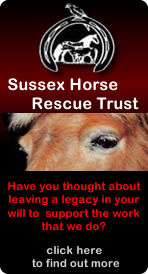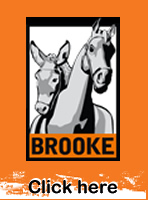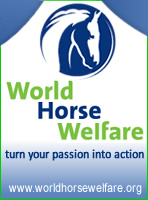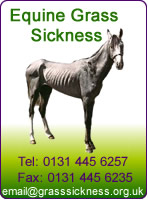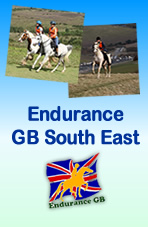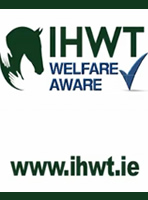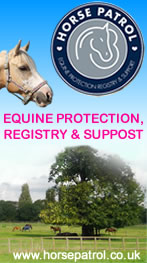
Horseytalk.net Special Interview
Sue Anderson
This is no ordinary riding class and these are no ordinary children. Because every one of them has a physical, mental or learning disability.
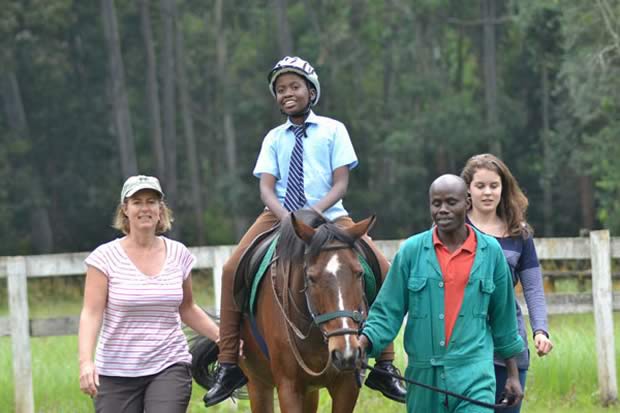
Volunteer charity uses animals to develop sensor-motor skills in young ones affected by mental and developmental disorders.
PHOTO| KARI MUTU
In a large, grassy field tucked inside a residential area in Karen, Kenya children as young as four years are enjoying a session of horse riding.
But this is no ordinary riding class, and these are no ordinary children, because every one of them has a physical, mental or learning disability.
"We have a variety of disabilities, but there is a high proportion of cerebral palsy and autistic sufferers," explains Sue Anderson, a trained horse riding instructor and founder of the charity, Riding for the Disabled Association (RDA) Kenya.
For more than 20 years, Anderson and a group of volunteers have provided equine-assisted therapy for children, mostly from impoverished backgrounds, who suffer from developmental disorders, including muscular dystrophy, spinal injuries, polio, emotional and social delays.
The 45-minute riding class is led by an instructor, and every rider has three supporters — a syce (a horse attendant) who leads the horse, and two side-walkers, one on either side of the animal, to watch over and encourage the rider.
Some of the side-walkers are special-needs teachers and experienced staff from the centres the riders come from, but many are ordinary people who volunteer their services.
When the children arrive, they are kitted out with riding helmets, then led to the horses one by one. None of them seems afraid or anxious around the half-tonne animals. In fact, one or two autistic youngsters who arrive in a highly excitable state soon settle down after mounting their horses.
Sessions begin with a gentle walk around the field while, in the background, an old-school CD player churns out soft rock and pop music.
Then the instructor gets the children to perform simple tasks like raising their hands, clapping behind their backs or swinging their arms from side to side.
To a casual observer, it looks like simple fun, but as Jane Tyrell, a paediatric physiotherapist and RDA's chairlady explains, this is therapy in action.
"It's actually quite difficult to take your hands off the horse and put them on your head and balance," she explains.
Next come different activities using play items during which the children might have to reach out for a beach ball or toss a bean bag into a basket on the ground.
PALPABLE JOY
The exercises are designed to stretch the muscles, promote eye-hand coordination, focus attention, encourage upright sitting, and control body movement, all normal skills that children with developmental challenges often lack.
The joy on the children's faces is palpable. "One of the brilliant things about riding is the sense of achievement and feeling that they're doing something," says Tyrell.
Equine-assisted therapy uses the movement of the horse to create muscle and sensory stimulation that bring about physical, emotional and cognitive rehabilitation. It has to do with the rhythmic, repetitive gait of a horse.
"When you're on a horse, its movement completely mimics what is happening in your pelvis. The horse gives the experience of normal pelvic movement and minimises abnormal movement," says Tyrell. "It's not something the children learn, but something the movement does to their bodies."
On what promoted the creation of RDA, Anderson says the charity was started in 1996 "after two young, Kenyan riders participated in the Special Olympics in the US and they came back with a variety of medals".
Joshua Agare and Rebekah Sudman participated in equestrian events at the 1995 Special Olympics World Summer Games in Connecticut, US and their success spurred Anderson, a trained nurse, to create a horse riding programme for children with developmental disabilities.
Agare, who was 16 at the time, had never sat on a horse before and had only trained for six months before the Special Olympics, where he won gold medals in individual and team events.
"It was the greatest moment in my life!" recalls Agare, who sits on the board of Special Olympics Kenya. "How many Kenyans get an opportunity to ride a horse? Yet, here I was, doing it for fun and winning medals."
As a child, Agare had struggled through primary school due to poor and slow reading skills. Later, he was moved to Fairmile School for children with developmental disabilities and enrolled into the RDA riding programme.
Now a professional athlete in men's handball, Agare has competed in multiple international events and will participate in the 2015 Special Olympics World Games in Los Angeles, US, from July 25 to August 2
He sums up the benefits of riding therapy: "It builds confidence, balance and control."
Fern Awinja Eshuchi, founder of Fairmile School and a certified early childhood specialist, has been partnering with the programme since its inception.
"It is a key therapy in improving concentration," notes Eshuchi, who first engaged in therapeutic riding in the UK. "It improves eye contact, thinking skills, motor skills, eye-hand coordination — all those skills that go into functional living."
MASSAGE GOING ON
"When they sit on a horse, it focuses their concentration and stimulates calmness in both the body and mind, as opposed to stimulating hyperactivity. There is a massage that is going on from the bottom," she adds, with a laugh.
Abisai Kuya is a rehabilitation assistant at Dagoretti Children's Centre in Nairobi and has been accompanying groups of disabled children to horse riding therapy for 10 years.
"It's helping our kids with balance, coordination and trunk control," he notes. "It's one of the best activities."
There is still a huge stigma attached to physical and mental disabilities in the country. The Dagoretti centre's outreach programme regularly finds disabled children hidden away in homes for years with little stimulation or human contact, perhaps due to traditional beliefs surrounding disability or lack of awareness of the medical treatments available.
In one case, a six-year-old boy who currently attends the riding classes was found in a village at the age of four, weighing just five kilogrammes.
His bones and muscles were severely underdeveloped, and he could not hold up his head, but now Tyrell is confident about the outlook for the boy.
"If he can sit up and hold something in his hand, feed himself and make eye contact with people, then he'll go to school. But if he's lying down, they'll never take him to school," she says of some parents of children with disability.
RDA Kenya regularly invites students from local schools to volunteer as part of their community service programme.
"Sure, we're about therapeutic riding, but we're also about changing the perception of disabled children and, hopefully, we've got a new generation coming up that understands more," says Tyrell.
Hippotherapy and therapeutic horse riding can only be carried out by a certified therapist or professional riding instructor. Hippotherapy is a much more refined form of equine treatment and it is uses specific movements of the horse for specific disabilities or weaknesses, explains Anderson.
"We neither have the horse nor an instructor to do this in Kenya," she says.
Setting up RDA Kenya was no easy task, as registration took almost two years. Prior to this, Anderson trained and qualified as a disabled riding instructor with Riding for the Disabled Association in the UK.
Then suitable horses had to be found and specially trained because safety is of utmost importance.
"Finding the right horse is very difficult," says Anderson. "Not only do they have to have to be sound and have the right conformation, but they must also have to have a suitable temperament.
The horse has to be sound enough to hold its balance with a fairly unbalanced rider
Horses also have their own 'mental baggage', which includes effects from racing, playing polo or other such activities.
"Also, we don't want very young, flighty horses," Anderson continues. "You want sort of middle-aged horses, that haven't gone through too much, their joints are still good, and they're of sound mind."
The personality of the horse also matters. Some horses are "generous-hearted, some are scared of everything, while some cannot concentrate".
"So a kind horse gets what we're doing and is willing to trust us. And you've got to be able to trust a horse completely," says Tyrell.
The horses are trained in therapeutic riding exercises then carefully incorporated into the programme. Anderson allocates horses for each session.
"Certain children get on better with certain horses. You're planning not just the size, but the temperament as well. Some horses bring out the best in some children and some horses bring out the worst."
THE YOUNGER, THE BETTER
At present, the programme focuses on children because, as Anderson puts it, "the younger, the better, because they're more malleable".
"From our point of view, it's more constructive to take the younger child because we're going to make more progress," adds Tyrell.
"It doesn't mean we never take older children, because sometimes we do. We just have to check very carefully who's going to benefit the most."
The children are individually selected for the programme, with each one's condition reviewed, medical records studied and parental consent obtained.
Equine therapy is not a panacea for all physical or cognitive disabilities, says Tyrell. "There are some riders with conditions we have to make sure don't get on a horse, such as brittle bones, haemophilia, epilepsy and severe scoliosis, which is curvature of the spine."
Where it is recommended, therapeutic riding is combined with other therapies for occupational, physical and cognitive rehabilitation.
The voluntary nature of RDA Kenya means that the twice-weekly programme can only take on a limited number of children. The association relies entirely on donations to fund its activities, buy the costly riding equipment, maintain the horses and employ syces. All other personnel are volunteers, including the side-walkers and committee members.
A supporter of the programme allows them the use of her field every week at no cost. The riders are charged a minimal fee, although some children cannot afford even this. "Those who can, pay; and for those who can't, we either subsidise or find a sponsor," says Anderson.
Various fundraising events enable RDA Kenya to sustain but not to expand its services. "I would love somebody to come from Mombasa and say, 'We have ponies here, how can we help?'" says Anderson. "We would give as much input as we could."
Volunteer commitment is also essential. "If we could employ instructors, we could do seven days a week," says Tyrell. "For every child you take riding, you need three volunteers. You can only really volunteer so much, and that is part of our limitation."
RDA hopes to one day grow the existing set-up into a permanent therapeutic riding centre where more children with disabilities can gain the sensor-motor skills and self-confidence they need for functional living, learning and integration into society.
SOME BENEFITS CANNOT BE FULLY EXPLAINED
Jane Tyrell admits that some benefits of horse-assisted therapy cannot be fully explained. The horses, for instance, understand autistic children and will tolerate behaviour from those children that they will not tolerate from an able-bodied rider.
Autistic children often have trouble with eye contact and bonding, but they seem to connect easily with horses, which can improve their communication and social skills.
While scientific research on equine therapy is still ongoing, for centuries it has been known that interacting with animals promotes emotional and psychological well-being in people.
Ancient Greek writings from around 400 BC speak of the benefits of horseback therapy. In 1875, French neurologist Charles Chassaignac was one of the first to demonstrate that patients with neurological and physical disorders show improved balance, muscle tone, joint movement and self-esteem from therapeutic horse riding.
But it wasn't until a wheelchair-bound Danish woman competed in equestrian events at the 1952 Helsinki Olympic Games that horse-assisted therapy gained global attention.
Her achievement spurred new therapeutic riding centres across Europe and North America, with treatments being developed for people with limited mobility and cognitive function.
In later years, movies such as War Horse and The Horse Whisperer helped to re-ignite public interest in horse therapy. Today, hippotherapy and therapeutic riding are recognised disciplines for treating physical and psychological conditions.


